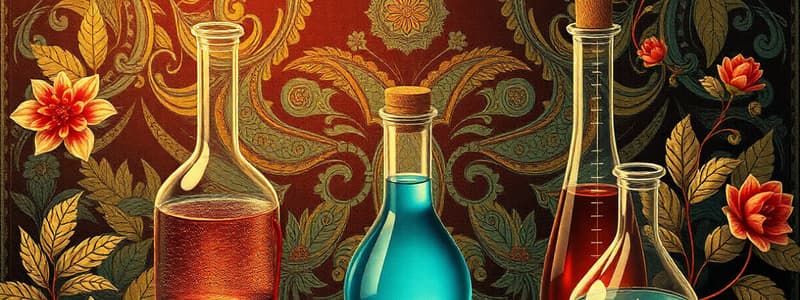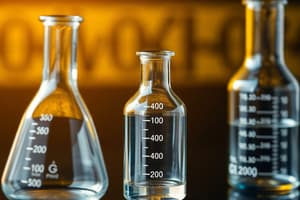Podcast
Questions and Answers
What happens when hot and cold objects touch?
What happens when hot and cold objects touch?
Heat transfers from the hotter object to the colder object until they reach thermal equilibrium.
Measurements consist of a ______ and a ______.
Measurements consist of a ______ and a ______.
number, unit
The final digit of a measurement is?
The final digit of a measurement is?
estimated
What metal does hemoglobin contain?
What metal does hemoglobin contain?
The nucleus of an atom is made up of ______ and ______. It has a ______ charge.
The nucleus of an atom is made up of ______ and ______. It has a ______ charge.
Elements are identified by their?
Elements are identified by their?
Ionic compounds are also known as?
Ionic compounds are also known as?
What is an ionic bond?
What is an ionic bond?
Cations ______ electrons and have a ______ charge.
Cations ______ electrons and have a ______ charge.
What is a covalent bond?
What is a covalent bond?
Metals ______ electrons and nonmetals ______ electrons.
Metals ______ electrons and nonmetals ______ electrons.
What type of elements form cations?
What type of elements form cations?
Ionic compounds start with?
Ionic compounds start with?
Covalent compounds start with?
Covalent compounds start with?
What does 'tetra' mean?
What does 'tetra' mean?
With regards to electrons, one bond shares ? electrons, two bonds share ? electrons, and three bonds share ? electrons.
With regards to electrons, one bond shares ? electrons, two bonds share ? electrons, and three bonds share ? electrons.
People with diabetes have trouble controlling what?
People with diabetes have trouble controlling what?
1 mole = ______ representative particles.
1 mole = ______ representative particles.
What is a redox reaction?
What is a redox reaction?
What is the only strong acid produced in the body?
What is the only strong acid produced in the body?
Flashcards
Measurements
Measurements
Measurements consist of a number and a unit.
Final digit of a measurement
Final digit of a measurement
The final digit of a measurement is estimated.
Significant Figures (SF)
Significant Figures (SF)
Significant figures are the digits that carry meaning contributing to precision.
Nucleus composition
Nucleus composition
Signup and view all the flashcards
Atomic number
Atomic number
Signup and view all the flashcards
Cation
Cation
Signup and view all the flashcards
Anion
Anion
Signup and view all the flashcards
Ionic bond
Ionic bond
Signup and view all the flashcards
Covalent bond
Covalent bond
Signup and view all the flashcards
Lewis structure
Lewis structure
Signup and view all the flashcards
Mole
Mole
Signup and view all the flashcards
Molar mass
Molar mass
Signup and view all the flashcards
Intermolecular force (IMF)
Intermolecular force (IMF)
Signup and view all the flashcards
Balanced chemical equation
Balanced chemical equation
Signup and view all the flashcards
Reaction types
Reaction types
Signup and view all the flashcards
Redox reaction
Redox reaction
Signup and view all the flashcards
Strong acid in body
Strong acid in body
Signup and view all the flashcards
Half-life
Half-life
Signup and view all the flashcards
Electrons in bonds
Electrons in bonds
Signup and view all the flashcards
Valence electrons
Valence electrons
Signup and view all the flashcards
Metric unit conversion
Metric unit conversion
Signup and view all the flashcards
Naming compounds
Naming compounds
Signup and view all the flashcards
Combining elements
Combining elements
Signup and view all the flashcards
Understanding covalent compounds
Understanding covalent compounds
Signup and view all the flashcards
Properties of metals
Properties of metals
Signup and view all the flashcards
Electron geometry
Electron geometry
Signup and view all the flashcards
Diabetes control
Diabetes control
Signup and view all the flashcards
Study Notes
Measurements
- Measurements consist of a number and a unit.
Temperature Changes
- The study guide includes a question about what happens when hot and cold objects touch.
Significant Figures (SF)
- Understand significant figures (SF)
- Understand adding significant figures (SF).
Conversions
- Understand conversions between metric units.
Chemical Composition of Hemoglobin
- Hemoglobin contains a specific metal.
Atomic Structure
- The nucleus of an atom is made up of protons and neutrons.
- The nucleus has a positive charge.
Identifying Elements
- Elements are identified by their atomic number (also known as the proton number).
Characteristics of Metals
- Metals are good conductors of heat and electricity.
- Metals are malleable (can be hammered or shaped).
- Metals are ductile (can be drawn into wires).
- Metals are lustrous (shiny).
- Metals are typically solid at room temperature (except mercury, which is liquid).
- Metals usually have 1-3 valence electrons.
- Metals tend to lose valence electrons.
Valence Electrons & Charges
- Be able to identify main group valence electrons and their charges.
Naming Compounds
- Be comfortable naming ionic and covalent compounds.
Nuclear Equations
- Know the symbols for alpha (α) and beta (β) decay.
- Know how to write nuclear equations.
Half-Life Calculations
- Know how to calculate half-life.
Ionic Compounds
- Ionic compounds are also known as salts.
Ionic Bonds
- Understand ionic bonds.
Cations
- Cations have a positive charge and have lost electrons.
Covalent Bonds
- Understand covalent bonds.
Anions
- Anions are formed by elements that gain electrons, giving them a negative charge.
Ionic Compound Formation
- Ionic compounds start with a metal and a nonmetal.
Covalent Compound Formation
- Covalent compounds start with nonmetals.
Prefixes in Chemistry
- "Tetra" means four.
Electron Sharing in Bonds
- 1 bond shares 2 electrons.
- 2 bonds share 4 electrons.
- 3 bonds share 6 electrons.
Diabetes and Blood Sugar Control
- People with diabetes have trouble controlling their blood sugar levels.
Electron Geometry Charts
- Understand electron geometry charts.
Moles and Representative Particles
- A mole is a unit of measurement for atoms, ions, or molecules and equals 6.02 x 10^23 representative particles.
Molar Mass Calculations
- Know how to calculate molar mass.
Converting Between Grams and Moles
- Know how to convert between grams and moles of substances.
Converting Particles to Moles
- Know how to convert the number of representative particles to moles.
Balancing Chemical Equations
- Know how to balance chemical equations.
Predicting Reaction Types
- Understand types of reactions (combination, decomposition, single displacement, double displacement, redox).
Calculating Mass from a Balanced Equation
- Using a balanced chemical equation, calculate the mass of one substance given the mass of another.
Redox Reactions
- Understand redox (oxidation-reduction) reactions
Strong Acid in the Body
- Identify the only strong acid produced in the body.
Studying That Suits You
Use AI to generate personalized quizzes and flashcards to suit your learning preferences.
Related Documents
Description
Explore key concepts in chemistry including measurements, temperature changes, significant figures, and the chemical composition of hemoglobin. This quiz covers atomic structure, the identification of elements, and the characteristics of metals. Test your knowledge and deepen your understanding of these fundamental topics.




